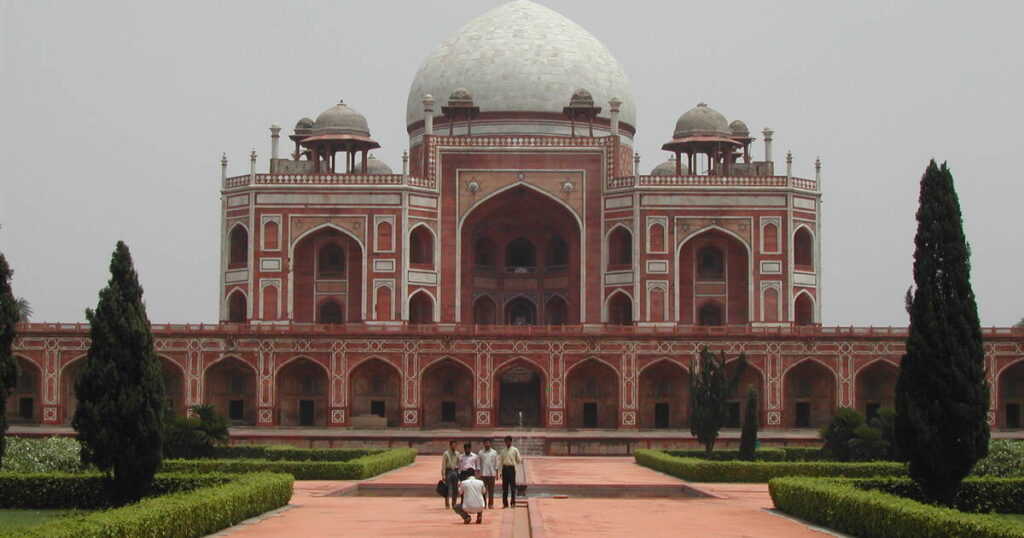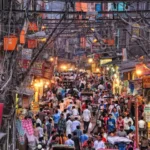Nestled amidst the hustle of modern Delhi lies an oasis of Mughal elegance, whispering tales of power, loss, and legacy. The Humayun Tomb, an architectural jewel that predates the Taj Mahal, is not just a tomb—it’s a glorious symbol of India’s fusion of Persian grace and Indian craftsmanship. Built in the mid-16th century, this monument marks the beginning of a grand architectural tradition in Mughal India. But beyond its red sandstone walls and white marble domes lies a compelling narrative often overlooked by casual visitors.
The Story Behind the Stone
Commissioned by Empress Bega Begum in 1565, nine years after Emperor Humayun’s death, the tomb was designed by Persian architect Mirak Mirza Ghiyas. It was the first garden-tomb on the Indian subcontinent and the first structure to use red sandstone on such a scale.
What makes this monument even more fascinating is the emotional impulse behind it. Empress Bega Begum was heartbroken by her husband’s death and resolved to build a memorial that immortalized his memory. She dedicated her life and resources to the project—a love story in stone, much like what the Taj Mahal would become decades later.
A Preview of the Taj Mahal
If you’ve ever wondered where the Taj Mahal got its inspiration, the answer is right here. The Humayun Tomb introduced India to the Charbagh garden layout, a quadrilateral garden divided by walkways or water channels, which later became iconic in Mughal architecture.
| Architectural Feature | Humayun Tomb | Taj Mahal |
|---|---|---|
| Built in | 1565-1572 | 1632-1653 |
| Commissioned by | Empress Bega Begum | Emperor Shah Jahan |
| Main Material | Red sandstone with white marble | White marble |
| Architectural Style | Persian + Indian | Refined Mughal + Persian + Indian |
| Garden Layout | Charbagh (four-part garden) | Charbagh with reflecting pools |
While the Taj is a visual spectacle of symmetry and opulence, Humayun’s tomb is more subtle in its grandeur. Yet, many historians argue that without Humayun’s tomb, the Taj might never have taken the form it did.
Why It Stands Out
Here’s what sets Humayun’s Tomb apart:
- Architectural innovation: It was the first time that Persian-style double domes, arched facades, and intricate lattice work were used at this scale in India.
- Garden symbolism: The Charbagh garden isn’t just decorative; it symbolizes the Islamic idea of paradise.
- Resting place of dynasties: More than 150 Mughal family members are buried here, including Dara Shikoh (Shah Jahan’s son), making it a dynastic necropolis.
A Personal Encounter
On a cool winter morning, I visited the tomb with low expectations. But as the sun rose, casting golden hues on the domes, something shifted. The silence, broken only by chirping birds and crunching gravel, felt sacred. Standing at the center of the Charbagh, I imagined Humayun returning from his campaigns, unaware that centuries later, his tomb would inspire millions.
Delhi has many monuments, but Humayun’s Tomb evokes emotion. It’s not just about the dead emperor—it’s about love, loss, legacy, and the roots of Mughal artistry.
Restoration & Recognition
In 1993, the Humayun Tomb was declared a UNESCO World Heritage Site. Over the past few decades, organizations like Aga Khan Trust for Culture and Archaeological Survey of India have undertaken detailed restoration work. Their efforts have brought back the monument’s original glory, including its sunken water features and faded frescoes.
Today, the site is not only a tourist attraction but a case study in heritage conservation.
Best Time to Visit
- Early morning (8-10 AM): Lesser crowd, better light for photos.
- Winter months (Nov-Feb): Cool weather, ideal for exploring gardens.
- Avoid midday in summers: Delhi heat can be harsh, and the sandstone radiates heat.
Insider Tips
- Combine your visit with Isa Khan’s Tomb, located within the same complex. Built before Humayun’s, it’s a stunning example of pre-Mughal design.
- Hire a local guide or use an audio tour app for stories you won’t find on placards.
- Photography enthusiasts will love the reflections in water channels after rainfall.
Getting There
Located in Nizamuddin East, the tomb is easily accessible:
- Metro: Nearest station is JLN Stadium (Violet Line).
- Auto/Cab: A short ride from India Gate or Connaught Place.
- Entry Fee: ₵25 for Indians, ₵500 for foreign nationals (as of 2025).
Nearby Attractions
- Nizamuddin Dargah: A soulful Sufi shrine just minutes away.
- Sunder Nursery: A 90-acre heritage park perfect for picnics.
- Khan Market: Ideal for post-tour coffee or shopping.
Final Thoughts
The Humayun Tomb isn’t just a Mughal monument—it’s a beginning. A beginning of architectural dreams, royal expression, and India’s most refined design journey. Whether you’re a history buff, an architecture enthusiast, or a casual explorer, this site promises more than just photos. It offers perspective.
📣 Call-to-Action (CTA)
Have you visited Humayun’s Tomb? Share your experience in the comments below! Or explore more hidden gems and iconic landmarks in Delhi through our Heritage & Monuments section. Don’t forget to subscribe for weekly travel stories from Dilli Atlas!



